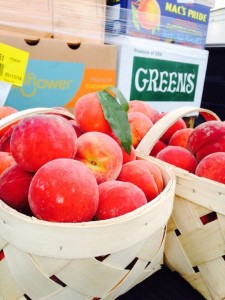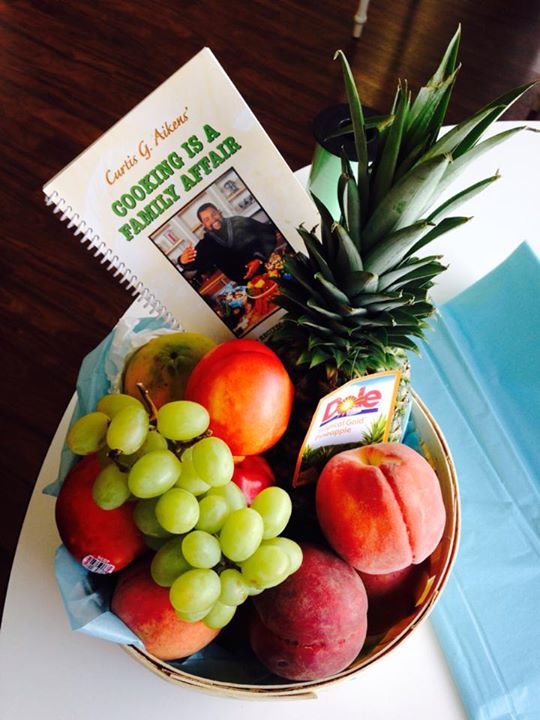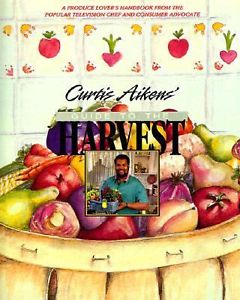Becoming a Better Garden Grocer, From Guide to the Harvest When I broke into the produce business way back when I thought I knew everything. There was a lot to know about fresh fruits and vegetables. You see, as a little boy, I was always around produce. My grandfather, WH Curtis, Sr. was the best farmer I ever saw, which brings me to the first term I would like to talk about: Organic. Granddaddy, like most of the old timers, farmed organically long before we knew of nitrates leaching into our soul, the potential effect of alar and pesticides. Granddaddy thought that the old way was the best way. I can remember him saying, “I’ve seen lots of collard greens grown with bag fertilizer, but I ain’t never seen any as good as mine, and I know they don’t taste better.” My dictionary says “organically grown” means using fertilizer and mulches consisting only of animal or vegetable matter with no chemical fertilizers or pesticides. That’s the way Granddaddy did it, and he did it cost-effectively. With that in mind, when shopping for organic fruits and vegetables, never settle for limp, driedlooking produce. If an organic retailer tells you the produce looks bad because the farmer can’t use pesticides than you politely inform him or her that the supplier isn’t much of an organic farmer. One more Granddaddy story: He used to apply a white, milky looking liquid to his garden. He didn’t have a fancy name for it. He just referred to it as a lime mix. Nowadays, it is called Bordeaux, and it is making a strong impact on the modern organic farmers. You may never see the next few terms listed in the produce section or featured in any written advertisements, but knowing them and what they stand for will help you select fresher and sweeter produce. This knowledge will also save you money. When I started to shop for wholesale produce, I thought an apple was an apple; a mushroom, a mushroom; and a zucchini, a zucchini. I had no idea a single produce item could be graded into one of no less than four categories. “Extra-fancy” is the highest grade. Then comes “fancy,” “choice,” and finally “mature,” sometimes referred to as “number two.” I learned those categories and what they stood for relatively quickly, thanks to people like Joe Carcione, Pat Murphy, and Charlie Bettencourt. All were men that I knew while buying in the Golden Gate Produce Terminal in South San Francisco. Each separately took me under his wing and share his knowledge of the produce world. Before that, I would buy what I was top grade, only to discover later I should have paid much less. The following grade levels are not USDA standards. They are trade terms that the men and women of the produce industry have devised over the years to discuss size, color and quality of fresh fruits and vegetables among themselves. Going from bottom to top, we’ll start with mature. A good produce person will never say he has some bad produce to sell; however, he will say for instance “I have some number two mushrooms, or soup tomatoes I’m sure you could put to use.” Remember, just because these items are our lowest grade does not mean the produce is bad or inedible. For example, number two mushrooms should not always be passed by. These mushrooms are mature and fullflavored, which makes them excellent for sauces and on pizzas. The soup tomato is another mature item that is too soft for sandwiches but excellent in soups and other cooked dishes.
Granddaddy thought that the old way was the best way. I can remember him saying, “I’ve seen lots of collard greens grown with bag fertilizer, but I ain’t never seen any as good as mine, and I know they don’t taste better.” My dictionary says “organically grown” means using fertilizer and mulches consisting only of animal or vegetable matter with no chemical fertilizers or pesticides. That’s the way Granddaddy did it, and he did it cost-effectively. With that in mind, when shopping for organic fruits and vegetables, never settle for limp, driedlooking produce. If an organic retailer tells you the produce looks bad because the farmer can’t use pesticides than you politely inform him or her that the supplier isn’t much of an organic farmer. One more Granddaddy story: He used to apply a white, milky looking liquid to his garden. He didn’t have a fancy name for it. He just referred to it as a lime mix. Nowadays, it is called Bordeaux, and it is making a strong impact on the modern organic farmers. You may never see the next few terms listed in the produce section or featured in any written advertisements, but knowing them and what they stand for will help you select fresher and sweeter produce. This knowledge will also save you money. When I started to shop for wholesale produce, I thought an apple was an apple; a mushroom, a mushroom; and a zucchini, a zucchini. I had no idea a single produce item could be graded into one of no less than four categories. “Extra-fancy” is the highest grade. Then comes “fancy,” “choice,” and finally “mature,” sometimes referred to as “number two.” I learned those categories and what they stood for relatively quickly, thanks to people like Joe Carcione, Pat Murphy, and Charlie Bettencourt. All were men that I knew while buying in the Golden Gate Produce Terminal in South San Francisco. Each separately took me under his wing and share his knowledge of the produce world. Before that, I would buy what I was top grade, only to discover later I should have paid much less. The following grade levels are not USDA standards. They are trade terms that the men and women of the produce industry have devised over the years to discuss size, color and quality of fresh fruits and vegetables among themselves. Going from bottom to top, we’ll start with mature. A good produce person will never say he has some bad produce to sell; however, he will say for instance “I have some number two mushrooms, or soup tomatoes I’m sure you could put to use.” Remember, just because these items are our lowest grade does not mean the produce is bad or inedible. For example, number two mushrooms should not always be passed by. These mushrooms are mature and fullflavored, which makes them excellent for sauces and on pizzas. The soup tomato is another mature item that is too soft for sandwiches but excellent in soups and other cooked dishes.
The next produce grade level is choice. Vegetables with this grade level are usually considered irregular, be its size or shape; however, the taste is normally as good as any of the top grades. Fruits with this grade usually show slight blemishes. For the consumer on a close budget, the choice items could be your best shopping value. The top two grades, fancy and extra fancy, are very hard to tell apart in fruits. With apples, for instance, an extra fancy apple shows 90 to 100 percent color. In other words, a red apple is completely red or close to it. Fancy apples show 75 to 90 percent color, although the taste is virtually the same. But the price could range from a difference of ten to twenty cents per pound. Now in vegetables, these grades of fancy and extra fancy usually stand the size, fancy being mediumsized. I’ll use a zucchini for our measuring stick: a fancy would be six to eight inches long and from one an onehalf to two inches around an extra fancy would be four inches long and no more than an inch and onehalf around. Small vegetables usually bring much higher price tags in most markets. However, taste does not vary much between fancy and extra fancy vegetables. Now that you are familiar with some of the produce industry’s inside grade levels and What they mean, I want you to know what I think are the four keys needed to unlock the door to becoming an expert greengrocer. These keys should guide you through an produce section, helping you choose the freshest sweetest fruits and vegetables available. One and more of these keys will always come into play in selecting fresh fruits or vegetables Becoming a Better Garden Grocer, From Guide to the Harvest When I broke into the produce business way back when, I thought I knew everything there was to know about fresh fruits and vegetables. You see, as a little boy, I was always around produce. My grandfather, WH Curtis, Sr. was the best farmer I ever saw, which brings me to the first term I would like to talk about organic. Granddaddy, like most of the oldtimers, farmed organically long before we knew of nitrates leaching into our soul, the potential effect of alar and pesticides. Granddaddy thought that the old way was the best way. I can remember him saying, “I’ve seen lots of collard greens grown with bag fertilizer, but I ain’t never seen any as good as mine, and I know they don’t taste better.” My dictionary says “organically grown” means using fertilizer and mulches consisting only of animal or vegetable matter with no chemical fertilizers or pesticides. That’s the way Granddaddy did it, and he did it cost-effectively. With that in mind, when shopping for organic fruits and vegetables, never settle for limp, driedlooking produce. If an organic retailer tells you the produce looks bad because the farmer can’t use pesticides, than you politely inform him or her that the supplier isn’t much of an organic farmer. One more Granddaddy story: He used to apply a white, milkylooking liquid to his garden. He didn’t have a fancy name for it. He just referred to it as a lime mix. Nowadays, it is called Bordeaux, and it is making a strong impact on the modern organic farmers. You may never see the next few terms listed in the produce section or featured in any written advertisements, but knowing them and what they stand for will help you select fresher and sweeter produce. This knowledge will also save you money. When I started to shop for wholesale produce, I thought an apple was an apple; a mushroom, a mushroom; and a zucchini, a zucchini. I had no idea a single produce item could be graded into one of no less that four categories. “Extra fancy” is the highest grade. Then comes “fancy,” “choice,” and finally “mature,” sometimes referred to as “number two.” I learned those categories and what they stood for relatively quickly, thanks to people like Joe Carcione, Pat Murphy, and Charlie Bettencourt. All were men that I knew while buying in the Golden Gate Produce Terminal in South San Francisco. Each separately took me under his wing and share his knowledge of the produce world. Before that, I would buy what I was top grade, only to discover later I should have paid much less. The following grade levels are not USDA standards. They are trade terms that the men and women of the produce industry have devised over the years to discuss size, color and quality of fresh fruits and vegetables among themselves. Going from bottom to top, we’ll start with mature. A good produce person will never say he has some bad produce to sell; however, he will say for instance “I have some number two mushrooms, or soup tomatoes I’m sure you could put to use.” Remember, just because these items are our lowest grade does not mean the produce is bad or inedible. For example, number two mushrooms should not always be passed by. These mushrooms are mature and fullflavored, which makes them excellent for sauces and on pizzas. The soup tomato is another mature item that is too soft for sandwiches but excellent in soups and other cooked dishes.
The next produce grade level is choice. Vegetables with this grade level are usually considered irregular, be its size or shape; however, the taste is normally as good as any of the top grades. Fruits with this grade usually show slight blemishes. For the consumer on a close budget, the choice items could be your best shopping value. The top two grades, fancy and extra fancy, are very hard to tell apart in fruits. With apples, for instance, an extra fancy apple shows 90 to 100 percent color. In other words, a red apple is completely red or close to it. Fancy apples show 75 to 90 percent color, although the taste is virtually the same. But the price could range from a difference of ten to twenty cents per pound. Now in vegetables, these grades of fancy and extra fancy usually stand the size, fancy being mediumsized. I’ll use a zucchini for our measuring stick: a fancy would be six to eight inches long and from one an onehalf to two inches around an extra fancy would be four inches long and no more than an inch and onehalf around. Small vegetables usually bring much higher price tags in most markets. However, taste does not vary much between fancy and extra fancy vegetables. Now that you are familiar with some of the produce industry’s inside grade levels and what they mean, I want you to know what I think are the four keys needed to unlock the door to becoming an expert greengrocer. These keys should guide you through an produce section, helping you choose the freshest sweetest fruits and vegetables available. One and more of these keys will always come into play in selecting fresh fruits or vegetables



